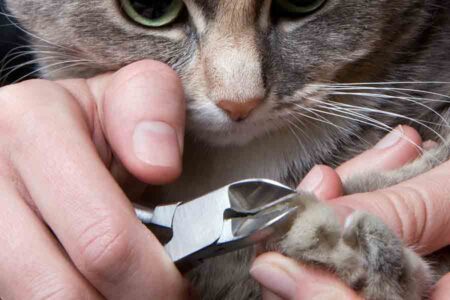Do you have a cat who has started scratching your furniture? Maybe, you’re thinking about adopting a new kitten, but want to prevent her from leaving scratch marks all over your furniture. Cats make great pets, but it can be very frustrating when they use their claws and ruin your furniture!
It is necessary for cats to scratch in order to keep their nails sharp, strengthen their upper bodies, and mark their territory. While it is necessary for cats to be able to scratch, it is not necessary for them to do so on your furniture. There are a number of steps you can take to prevent your cat from scratching your furniture.
[amazon bestseller=”cat scratching prevention for furniture”]
1. Reduce Your Cat’s Stress Level
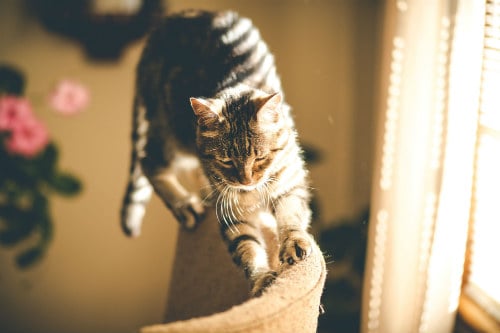
Sometimes, when a cat is feeling stressed, it can cause the cat to act out in different ways. This could mean they are urinating more outside of the litter box. Or, perhaps their stress is what is causing them to scratch your couch.
There are different reasons your cat could be feeling stress. If you have been feeling stressed or worried about something, chances are it is affecting the way you are interacting with your cat, and thus how they are feeling.
Other changes to your cat’s routines and day-to-day experiences can also cause stress. Did you recently get a new pet? Did your boyfriend just move in?
Work on reducing your cat’s stress level. Make sure you are giving them enough attention. Take time to play with them each evening after you get home from work so they feel loved.
There are also sprays and diffusers you can use around your house to help your cat feel calmer. Feliway mimics cats’ pheromones to help reduce their level of stress. You can use this in the areas where scratching is a problem.
If you have tried to make your cat feel more at ease, but you still are noticing a problem, reach out to your veterinarian. They can offer you more suggestions, or in certain circumstances prescribe a medication to help calm down your cat.
2. Trim Your Cat’s Nails
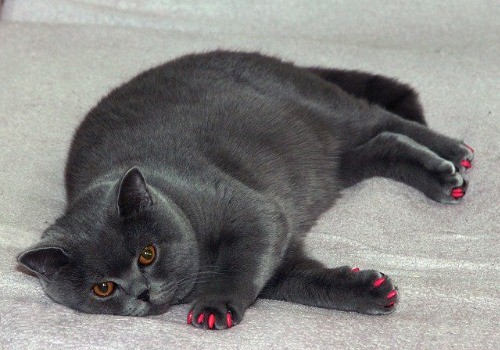
Trimming your cat’s nails may also help decrease scratching. Sometimes when a cat’s nails are shorter, they are not as tempted to scratch. Ideally, you should cut your cat’s nails about every two to three weeks.
[amazon bestseller=”cat nail clippers”]
Trimming a cat’s nails can often be challenging. If you start the habit when your cat is a kitten, they will be more used to it, and less likely to try to resist.
When you’re trimming your cat’s nails, go slow and be careful. A cat’s paws are sensitive and you need to be careful not to trim the nail too short and cause your cat to bleed. You just want to cut the clear tip of the nail; not the pink part below the tip.
Finally, choose the right pair of nail clippers. You want your nail clippers to be sharp so they will cut, not bend the nail. You can also find nail clippers that are designed for safety so you won’t over trim the nails.
3. Purchase Scratching Posts
As you read above, cats need to scratch. So, if you don’t want your cat to scratch on your furniture, you need to provide them with alternative locations where they are allowed to scratch. You will want to purchase multiple scratching posts or cat trees to have in various rooms in your house.
It is going to be important to invest in more than just one scratching post. You don’t want to put one in the bedroom to break your cat’s habit of scratching your bed only to have them discover the leg of your dining room table!
Consider putting a scratching post near your cat’s preferred area to scratch. If they seem to really like scratching the edge of your couch, place a scratching post close by.
When you are selecting scratching posts, consider the material they are made from. Many scratching posts are made from cardboard. Your cat may like scratching these, but be prepared for a mess and to need to replace them frequently.
For a little more money, you can find scratching posts and cat trees that mimic the materials found in your home. These are often made from carpeting and sisal. Your cat will enjoy scratching these materials, and they will last for a long time.
4. Reward Your Cat
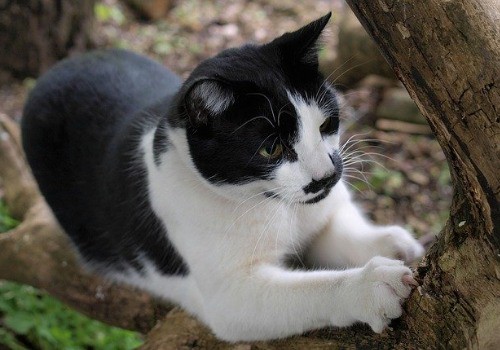
This step is simple. When you see your cat scratching on their new scratching post or another desirable location, reward them. There are different methods you can use to reward your cat.
One way to reward your cat is by using verbal praise. Use their name and speak to them in a friendly voice telling them that they are doing a good job scratching on their scratching post.
You can also reward them by giving them physical attention. Immediately after you see them scratching on the cat tree, go over and pet them. Rub them in their favorite spot.
Finally, treats can also be used as a reward. You’ll want to have the treat container handy so you are able to give them a treat immediately after they scratched in a desirable location.
[amazon bestseller=”cats scratching post”]
5. Make Your Furniture ‘Unattractive’ for Scratching
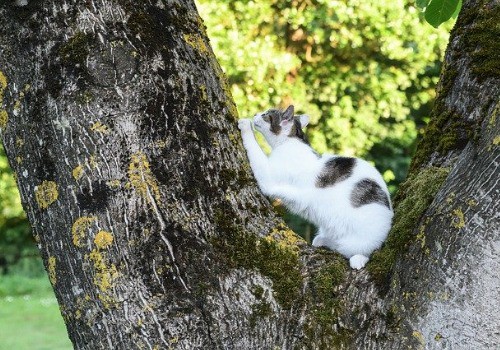
If you’ve purchased scratching posts and you’re noticing that your cat is still choosing to scratch your furniture, you can try to make the furniture unattractive for scratching. You can accomplish this step in different ways.
You can cover the area where your cat is scratching using a tape covers. They won’t like the sticky feel of the tape on their nails. You can also try to cover the area with foil.
If your cat has been going under a piece of furniture and scratching it from the bottom, consider blocking off their access. You can use a box to block them from getting under the table or a sheet tucked tightly to stop them from going under a couch or a bed.
6. Use Catnip
Another thing you can try if your cat doesn’t seem interested in those new scratching posts you purchased is to use catnip. Cats love the smell of catnip and will be attracted to areas where you rub it. So, if you rub some catnip near the scratching post, your curious kitty will likely go over to check it out.
7. Deter the Cat from Scratching in an Undesirable Location
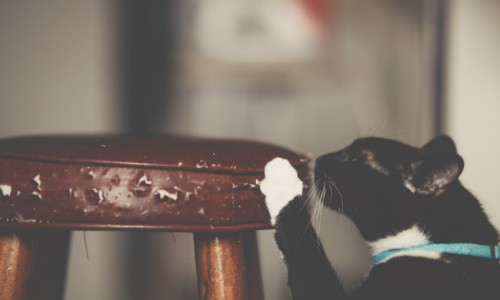
If you see your cat scratching on your furniture, try to deter them from doing so. You want to make them see scratching that furniture as an undesirable action because of the consequence they get when it happens.
You can deter your cat by using a quick spray of water. Since cats do not like water, if they associate scratching your couch with getting wet, they’ll be more likely to stop and find a new spot to scratch.
Another way to deter your cat from scratching is to make a sound when you see the cat scratching. Don’t use the cat’s name, rather make a quick hissing sound or say something like “ah”. Save using the cat’s name for when you are praising him for a desirable action.
Try a Deterrent Spray
You can buy sprays that are designed to deter your cat from scratching. You can purchase some herbal sprays that leave a smell that will make the area undesirable to your cat. Check the ingredients and make sure there is nothing in the product you are considering that could be harmful to your cat.
8. Consider Using a Nail Cover
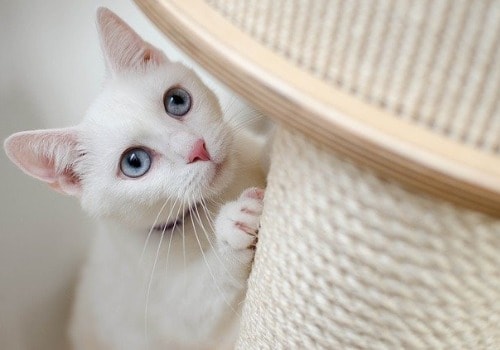
If you’ve tried using the suggestions above, and your cat is still scratching your furniture, there are nail covers you can use to cover your cat’s nails. These plastic caps go over your cats claws so they can’t use them for scratching. Your cat will need to be patient enough for either you or your veterinarian to put them on!
[amazon bestseller=”Cat Scratcher Cardboard”]
Don’t Declaw Your Cat
Even if scratching is a problem, you should not declaw a cat. When you declaw a cat, you are basically amputating one-third of their paw. This can be very painful for your cat and can even lead to problems with aggression.
Cats need their claws for self-defense and climbing. If you declaw a cat and your cat goes outside (either as an outdoor cat or by escaping), they will have a much harder time surviving!
Conclusion
As you can see, there are many ideas you can implement to help prevent your cat from scratching your furniture. All cats are different; not every idea will work for every cat. You may have to try multiple ideas before you find the one that will work for your cat.
Also, keep in mind that if you are trying to stop a cat who has already been scratching furniture that the process might take some time. You are trying to help your cat learn a new routine and break them of bad habits. This will likely not happen overnight!
Cats can be wonderful companions. With the right strategies and some patience your cat will be using a scratching post instead of sharpening their claws on the leg of your dining room table!
"In ancient times cats were worshipped as gods; they have not forgotten this."
-- Terry Pratchett



